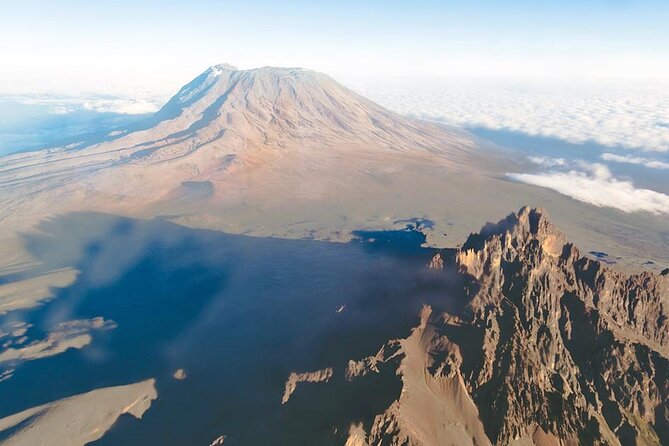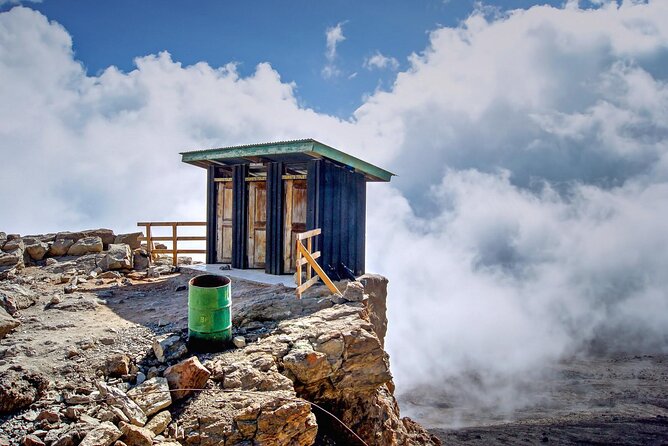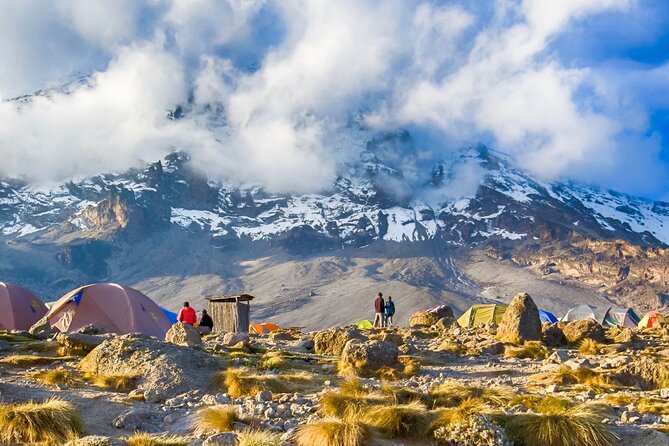When it comes to tackling Kilimanjaro, the Lemosho Route stands out for its stunning views and less-traveled paths. Hikers experience everything from lush rainforests to stark alpine deserts, making each day a new adventure. With a well-paced itinerary designed for acclimatization, trekkers can enjoy both the challenge and the beauty of the mountain. But what do you really need to pack for this epic journey, and what’s included in the trek? There’s more to discover about preparing for this unforgettable experience.
Key Points

- The Lemosho Route offers stunning scenery and fewer crowds, enhancing the trekking experience over seven days.
- Each day includes a mix of challenging and easier sections, allowing for gradual acclimatization.
- Camp life features hearty meals and fosters camaraderie among trekkers.
- Essential packing items include a waterproof jacket, warm layers, hiking boots, and a sleeping bag.
- Health and safety are prioritized with acclimatization strategies and hydration to prevent altitude sickness.
Overview of the Lemosho Route
When it comes to trekking Mount Kilimanjaro, the Lemosho Route stands out for its stunning scenery and less crowded paths.
This route offers trekkers a fantastic blend of lush rainforests, alpine meadows, and breathtaking vistas, making it a favorite for those seeking beauty along with adventure.
Spanning over seven days, the Lemosho Route allows for gradual acclimatization, giving climbers a better chance to summit successfully.
Plus, with its starting point away from the busier trails, hikers enjoy a more tranquil experience.
The trek’s diverse landscapes keep things interesting, and the chance to spot wildlife adds an extra thrill.
You can also read our reviews of more hiking tours in Arusha
Itinerary Breakdown

On day one of the Lemosho Route, hikers set off from the lush forests of the lower slopes, immediately seeing the vibrant surroundings. They trek through beautiful rainforests, spotting monkeys and colorful birds while enjoying the fresh mountain air.
Days two and three lead them higher, as they transition into moorland and then alpine desert, with stunning views of the summit ahead. Each day’s hike includes a mix of challenging sections and easier stretches, allowing everyone to soak in the beauty.
Camp life brings hearty meals and camaraderie around the fire. As they push toward the summit on day six, the excitement builds. Finally, on day seven, they celebrate their success, basking in the glory of Kilimanjaro’s peak!
Essential Packing List

Packing for a week-long trek up Kilimanjaro can feel a bit overwhelming, but with the right essentials, it becomes a breeze. To make sure you’re ready for the adventure, here’s a handy packing list:
| Item | Purpose |
|---|---|
| Waterproof Jacket | Keeps you dry in rain |
| Warm Layer | Provides insulation at night |
| Hiking Boots | Supports your feet on rugged trails |
| Sleeping Bag | Ensures comfort during sleep |
| Trekking Poles | Helps with balance and stability |
With this essential gear, trekkers will be all set for whatever the mountain throws their way. Happy packing, and get ready for an unforgettable journey!
What’s Included in the Package
Once trekkers have their gear sorted, it’s time to look at what the package offers for the Kilimanjaro adventure.
This all-inclusive deal covers pretty much everything you need for a smooth trek. You’ll benefit from all fees and taxes being taken care of, plus transfers to the gate and back at the end.
Professional guides and a dedicated support crew, including cooks and porters, are on hand to ensure a memorable experience.
You’ll enjoy seven breakfasts, six dinners, and seven lunches, keeping your energy up along the way.
Plus, there’s peace of mind with free cancellation and unlimited rescheduling up to 24 hours before the trek begins.
Just remember, tips and personal items aren’t included, so plan accordingly!
Meeting and Pickup Details

Before setting off on the adventure of a lifetime, trekkers will find it easy to meet up for the Kilimanjaro hike. The pickup happens at any hotel in Moshi, Tanzania, making it super convenient.
Participants just need to be ready by 8:00 am, and they’ll be whisked away to the starting point of their trek. It’s that simple!
After an exhilarating week on the mountain, they’ll return to the same hotel, where the journey began. This seamless arrangement ensures that everyone can focus on what really matters—enjoying the breathtaking views and creating unforgettable memories.
Plus, with a dedicated support crew handling the logistics, trekkers can relax and embrace every moment of their Kilimanjaro adventure.
You can also read our reviews of more tours and experiences in Arusha
Health and Safety Considerations

As trekkers gear up for their Kilimanjaro adventure, keeping health and safety in mind is a top priority.
Altitude sickness can hit hard, so it’s vital to acclimatize properly. Staying hydrated is key, too, as the high altitude can lead to dehydration faster than you might think.
Here are three essential health and safety tips:
-
Listen to Your Body: If you feel any symptoms of altitude sickness, don’t hesitate to alert your guide.
-
Stay Hydrated: Drink plenty of water throughout the trek to keep energy levels high.
-
Pack a First Aid Kit: Bring basic supplies like pain relievers, band-aids, and any personal medications.
A little preparation goes a long way in ensuring a safe and enjoyable trek!
Tips for a Successful Trek

Planning a successful trek up Kilimanjaro means being both prepared and flexible. Trekking isn’t just about reaching the summit; it’s about enjoying the journey. Here are some tips to keep in mind:
| Tip | Description | Why It Matters |
|---|---|---|
| Stay Hydrated | Drink plenty of water daily. | Helps prevent altitude sickness. |
| Pack Light | Only bring essentials. | Easier to carry your gear. |
| Listen to Your Body | Don’t push through fatigue. | Avoid serious health issues. |
| Embrace the Experience | Take breaks and enjoy the scenery. | Makes the trek more enjoyable. |
Frequently Asked Questions
What Is the Best Time of Year to Hike Kilimanjaro?
The best time to hike Kilimanjaro is during the dry seasons, from June to October and January to March. These months offer clearer skies and milder temperatures, making the trek more enjoyable and scenic for adventurers.
Are There Age Restrictions for Participants?
There aren’t strict age restrictions for participants, but most companies recommend hikers be at least 10 years old. It’s all about ensuring everyone’s fit enough to enjoy the adventure without any issues.
Can I Rent Hiking Gear in Moshi?
In Moshi, hikers can easily rent gear from various shops. They’ve got everything from boots to sleeping bags, so it’s convenient for travelers who don’t want to pack all their equipment.
What Is the Average Group Size for Hikes?
The average group size for hikes typically ranges from six to twelve people. This size keeps things personal and ensures everyone gets the attention they need from guides, making the experience more enjoyable for all.
Is There a Weight Limit for Porters?
Heard there’s a weight limit for porters, usually around 20 kilograms. This ensures everyone carries a manageable load, keeping the trek enjoyable for both hikers and porters. It’s all about teamwork and safety!
The Sum Up
In a nutshell, hiking Kilimanjaro via the Lemosho Route is an epic adventure that combines stunning landscapes with a supportive crew to make your journey unforgettable. With the right packing, a solid itinerary, and a focus on health and safety, you’re set for success. So grab your gear, rally your friends, and get ready to conquer Africa’s highest peak. Trust us, the thrill of reaching the summit is worth every step of the trek!
More 7-Day Experiences in Arusha
- 7 Days Tour Northern Tanzania Safari:
- 7 Days Kilimanjaro Mountain Hiking With Professional Guide
- 7 Days Group Camping Tarangire/Serengeti/Ngorongoro Crater and Lake Manyara
- 7-Day Mt. Kilimanjaro Hiking: Machame Route
- 7 Days Wildlife Safari Through Tanzania Best Parks
- 7 Days Kilimanjaro Climb via Machame Route (Whiskey Route)
More Hiking & Trekking Tours in Arusha
More Tour Reviews in Arusha
Not for you? Here's more nearby things to do in Arusha we have reviewed
- Mt Kilimanjaro Hiking via Marangu Route Day Trip
- 3days Tarangire,Ngorongoro Crater and Lake Manyara
- Tanzania Budget Camping Safaris
- Tanzanite Gemstone Mining Experience at Mererani Mines Day Tour
- 7 Days Tour Northern Tanzania Safari:
- Ngorongoro Day Trip From Arusha / Kilimanjaro
- 3 Days Tanzania Private Big 5 Safari With Midrange Lodge
- Tanzania Tours Group Sharing 3 Days 2025/2026
- From Arusha : 3 Days Private Safari Tarangire N.P and Serengeti
- Full Day Olduvai & The Enigmatic Shifting Sand Tour
- 5-Day Classic Tarangire, Serengeti & Ngorongoro Camping
- 4 Days Serengeti Splendor Adventure
